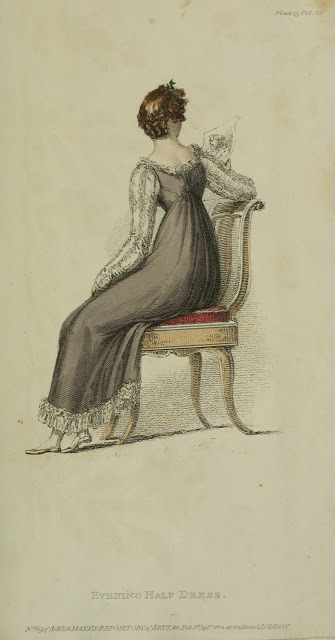Victoria here. Time to take a brief look at some of the fashions worn by ladies 200 years ago.
Here are a few examples from my collection of fashion prints from Regency-era magazines
This is framed on my wall...and I love it.
La Belle Assemblee
Dinner Dress and the Platoff Cap, April 1814,
"Invented and to be had only of Mrs. Bell
22 Upper Brooke Street, Bloomsbury"
The Oldenburgh Dinner Dress July 1814
French white satin slip, decorated round the bottom with a rich blond
lace, and headed with a superb pearl trimming: a wreath of laurel leaves formed
of pearls, in an angle in the front of the slip. The trimming is perfectly
novel, and the effect of it is more elegant than can be conceived from the
engraving which we have given. Over the slip is a short Russian robe of white crape,
open front, edged round with a rich pearl trimming to correspond with the slip;
the wreaths which ornament the robe is formed of pearls also, to correspond.
The front of the dress is formed in a most novel and tasteful style, peculiar
to the inventress, Mrs. Bell. The back continues full, and the waist very
short. Crape long sleeve, trimmed with pearl bands at regular distances. Small
lace cap, superbly decorated with pearls, and finished with tassels to
correspond; a fancy flower is placed to the side. The form of this cap is
extremely elegant, exquisitely tasteful, and becoming. A white satin Chapeau
Bras, ornamented with a spread eagle on the crown, worked in chenille, is
indispensable. The hair is worn up a-la-Grecque on the left side, where it is fastened
in a full knot. Gloves and slippers of white kid. Plain ivory fan.
Ackermann's September, 1814
Evening Half dress Published in Ackermann's Repository of Arts, September 1814
A plain frock, with full-drawn back, composed of striped sarsnet Italian net of peach-blossom colour; full flounce of blond lace, headed with tufts of the same; a quilling of blond round the top of the dress; long full sleeve of white satin, inlet with lace. Hair in short full curls behind, and blended with flowers on the front of the head. Slippers of white kid. Limerick gloves.
Somehow the artists at Ackermann's seemed to have fallen in love with rear views this year. There were quite a few.
Walking Dress, October 1814, Ackermann's
Walking dress Published in Ackermann's Repository of Arts, October 1814
An evening primrose-coloured French sarsnet petticoat, trimmed round the bottom with a double border of clear muslin, drawn full with narrow ribband of corresponding colour to the petticoat; high body of jaconot muslin, with reversed drawstrings; long sleeve, drawn to correspond. A silk ruff. A silk net handkerchief-sash, tied in streamers and small bows behind. A Shipton straw bonnet, tied under the chin with a net handkerchief crossing the crown, and trimmed with a band of the same silk net. Sandals of evening primrose-coloured kid. Gloves to correspond.
Walking Dress
Ladies Magazine, October, 1814
I have no description of this ensemble, but I love the hat -- and the casual pose. She looks quite modern.
I used some of these images on the e-book covers of my Regency Romances. I love them.
Ackermann's, December 1814 Head Dresses
Head dresses Published in Ackermann's Repository of Arts, December 1814
No. 1. A full turban, made either in tiffany or silver net; the crown lashed with silk or silver cords.
No. 2. A melon cap, made of white satin quilted, with narrow bead trimming inlet, ornamented with a full cluster and wreath of flowers, blended with a quilted border of lace.
No. 3. A Persian calash, formed upon a wire fabric, and composed of satin-striped ribband, trimmed with a full border of blonde lace, appliqued with a heading of Vandyke: a net handkerchief crosses the crown en suite, with a large cluster of wild flowers in the centre.
No. 4. A cottage bonnet, made in salmon colour and white velvets, ornamented with a double plume of ostrich feathers.
No. 5. A Russian-à-la-mode, composed of orange and white velvets, trimmed round the edge with a quilling of Vandyke lace; the crown decorated with flowers and wreaths of Vandyke lace.
It seems that 1814 was a banner year for portrait painters...and their lovely subjects' raiment. Here is an example.
Sir Thomas Lawrence, 1814
Lady Bagot, Lady Fitzroy Somerset (later Lady Raglan), and Lady Burghersh (later Countess of Westmorland), all three nee Wellesley-Pole. Three nieces of the Duke of Wellington in fashionable gowns.







If you didn't look good in white, it was hopeless.
ReplyDeleteFashions from 1814 were very elegant. However, I doubt very much that such high waists allow anyone's silhouette to taper so sharply unless they are missing a few ribs. Still, the drawings and dresses are lovely.
ReplyDelete